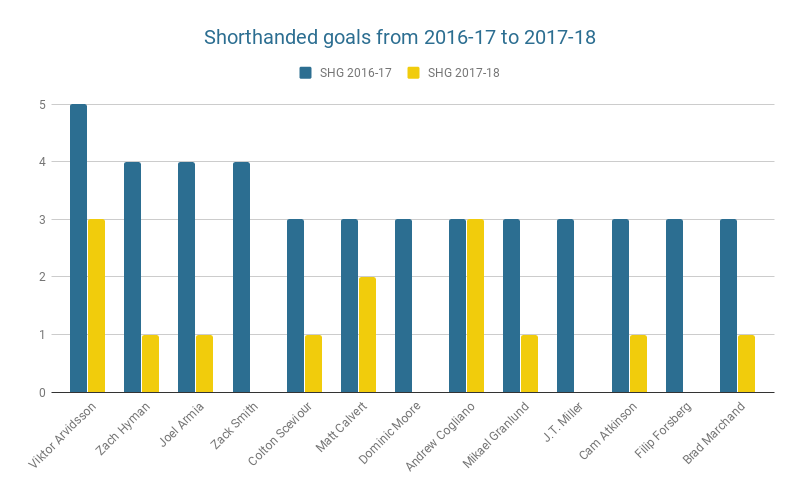Apparently I should write a critique of an element of the Canucks more often. Ever since I wrote about their penalty killing crisis, the Canucks haven’t allowed a power play goal. Through a combination of a little more discipline to avoid the penalty box and some sharper shorthanded work, the Canucks have gone four straight perfect games on the penalty kill.
More than that, on Thursday against the Nashville Predators, they outscored the Predators’ power play with two shorthanded goals.
The first was what we might consider a traditional shorthanded goal. The penalty kill created a turnover, in this case Markus Granlund picking off a pass in the neutral zone, that led to an odd-man rush the other way. That’s how most shorthanded goals are scored, if you consider a breakaway an odd-man rush.
The second goal, however, was an odd one, as it was both a shorthanded goal and, more or less, a 5-on-5 goal. Since the Canucks had Anders Nilsson pulled for the extra attacker, they were playing with five skaters when Bo Horvat finished off a Nikolay Goldobin rebound to tie the game and send it to overtime.
Scoring even one shorthanded goal is rare enough; three NHL teams, the Florida Panthers, Buffalo Sabres, and Pittsburgh Penguins, have yet to score one this season. Scoring two shorthanded goals is even more unusual.
Tuesday’s game was the 23rd time in Canucks history they have scored two shorthanded goals and just the fourth time they’ve done so in a loss. Unsurprisingly, scoring two shorthanded goals is a pretty good path towards out-scoring your opponent and winning the game.
The last time the Canucks scored two shorthanded goals in a game was in 2013, in a 6-2 win over the Edmonton Oilers. Defenceman Jason Garrison figured into both goals, assisting on Brad Richardson’s shorthanded goal in the first period, then scoring one himself into an empty net late in the third period.
That Richardson goal was just plain nasty, faking a shot, then faking a strong deke to the forehand before sliding the puck five-hole on Devan Dubnyk. Richardson will come back in a moment, along with another former Canuck.
That October 5, 2013 game against the Oilers was exactly 13 years, to the day, since the Canucks’ last game with two shorthanded goals. On October 5, 2000, Matt Cooke and Peter Schaefer both scored shorthanded goals in the first period against the Philadelphia Flyers, but the penalty kill gave up three goals in the second and third periods in a 6-3 loss.
What does it mean that those two games were on the same day, 13 years apart? Nothing. It’s just neat.
Games with two shorthanded goals are relatively rare, though obviously not unheard of. Heck, the Boston Bruins once scored three shorthanded goals on the same penalty, an NHL record. Games where one team scores two shorthanded goals have actually been happening with surprising frequency this season. There have been nine such games in the NHL in the 2018-19 season, which would be a pretty normal number for an entire season. What is particularly weird is that the uptick seems to be entirely because of one team.
The Arizona Coyotes have been involved in five of the nine games that have had one team score two shorthanded goals. In three of them, they’ve scored two shorthanded goals; in the other two games, they’ve been the victims, allowing two shorthanded goals.
That seems odd, but the Coyotes have been odd all season. The Coyotes lead the NHL with a whopping 11 shorthanded goals. In fact, they’ve out-scored their opponents while on the penalty kill, allowing just 8 power play goals. That’s right: the Coyotes have a plus-three goal differential on the penalty kill.
That’s wild. The Coyotes not only have the best penalty kill in the NHL, killing 90.7% of their penalties, but also have excelled at scoring shorthanded goals. If you think about it, they’re 11-for-86 shorthanded, so they score on 12.8% of their opponents’ power plays. The Chicago Blackhawks and Montreal Canadiens are 12.1% and 12.7% on the power play this season.
The Coyotes are better shorthanded than the Blackhawks and Canadiens are with the man advantage.
When it comes to shorthanded goals, the Coyotes are led by two former Canucks: Michael Grabner and Brad Richardson. Grabner has four of their 11 shorthanded goals, while Richardson is right behind him with three.
Grabner has earned a bit of a reputation for scoring shorthanded because of his speed, but that reputation was earned primarily in one season with the New York Islanders. He scored six shorthanded goals in 2010-11; the four he’s scored this season is the most he’s scored since then.
Still, Grabner’s 19 career shorthanded goals ties him for 80th all time in the NHL. Among active players, only Brad Marchand and Tomas Plekanec have more.
Richardson also has a history of scoring shorthanded goals, though he’s already matched his career-high of three in a season. His 14 career shorthanded goals tie him for 11th among active players.
It seems clear that scoring shorthanded goals is a legitimate skill — certain players are more likely to score shorthanded goals than others — but it’s also highly dependent on luck and circumstances. Grabner went from scoring six shorthanded goals in 2010-11 to scoring just one the following season. Did he suddenly become terrible at creating and finishing shorthanded chances? Probably not, but shorthanded goals are so rare and situation-dependent that you can’t rely on them.
For instance, in 2016-17 13 players had at least three shorthanded goals, led by Viktor Arvidsson with five. Just two of those players had at least three shorthanded goals the following season and the league was led by a player, Aleksander Barkov, who had no shorthanded goals the previous season.

There’s no consistency when it comes to team-level shorthanded goals either. Just look at the Coyotes: they had two shorthanded goals all of last season. Adding Grabner in free agency certainly helped, but he only had one shorthanded goal last season.
It also helps when opponents let in shorthanded goals like this one:
The Coyotes won’t touch the NHL record for most shorthanded goals in a season, held by the 1983-84 Edmonton Oilers. That season the Oilers scored a whopping 36 shorthanded goals, and the Oilers of the 80’s also have the second, third, and fourth best seasons.
The Coyotes are on-pace for 30 shorthanded goals, which would be the second most behind the 1983-84 Oilers, but the random nature of shorthanded goals makes it unlikely they’ll reach that total. The last team to even score 20 or more shorthanded goals was the 2005-06 Ottawa Senators and no other team in the 2000s has managed it.
With their two shorthanded goals on Thursday, the Canucks are now third in the NHL behind the Coyotes and Calgary Flames. They’ve had plenty of opportunities to score shorthanded goals: they’ve been shorthanded more than any other team in the NHL.



